Cards Up My Sleeve
It's the first non-theme week following the release of a new set. That means it's time for the "Mark tells stories about cards from the set" column. Ah, like the swallows returning to Capistrano, let us return to this fine tradition to hear some design stories and other miscellaneous stuff.
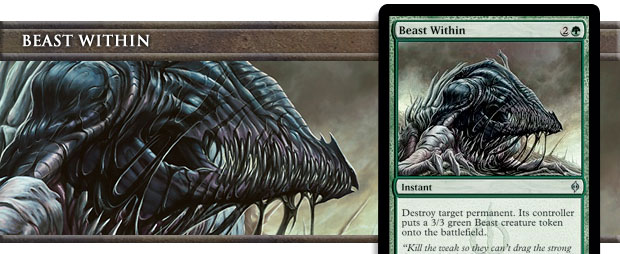

As one of the color pie gurus, I have mixed opinions on this card. I don't really mind it as a green kill card because it really isn't. Flavorwise, the card doesn't kill; it changes the object into a beast. (Yes, that makes a lot more sense when the original thing itself is a creature.) But green isn't the color of transformation—that's blue. So this card is a little out of place, but not for the reason many think at first glance.
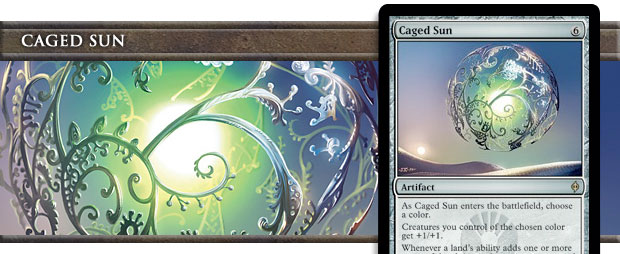

Different cards resonate with different type of players. Some cards resonate with designers. Those cards get to be remade time and time again. Can you identify what beloved designer card led to Caged Sun? (Hint: It's in Alpha.)
Click here to see the answer.
Yes, Gauntlet of Might. Some designer does the latest riff on Gauntlet of Might every once in a while. Why not in Scars of Mirrodin block?
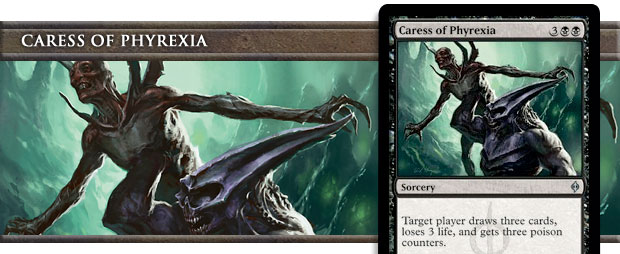

This card caused a lot of discussion. While I'm Ramp;D's biggest poison advocate, I was very wary of giving poison directly to other players. I much preferred that the player giving poison had to work a little to deliver the poison. I was okay with Ichor Rats in Scars of Mirrodin because it only gave one poison and was the only card like it in the set. I wasn't too keen with granting three poison with one card, but development promised me that this card, while splashy on the surface, wasn't going to make players die out of nowhere as often as one might assume.
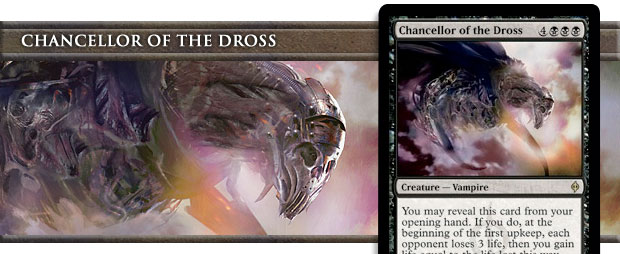

The most amazing thing to me about this card is that what is printed on the finished card is exactly what appeared on the card in the very first draft of this mechanic that Ken put into the file. I remember when I saw this card for the first time I laughed at how we'd never be able to print it without changes. Let me tip my hat to Ken. Well played, Mr. Nagle, well played.
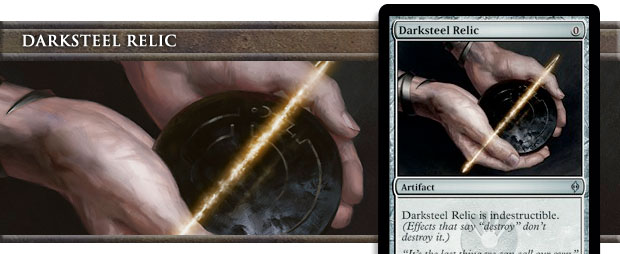

This was a very divisive card in design and development. One side disliked it because it didn't do much of anything while the other side loved it because it didn't do much of anything. In general, Ramp;D likes cards that evoke responses even if some of those responsive are negative. (Note there have to be enough positive responses to be worth doing it.)
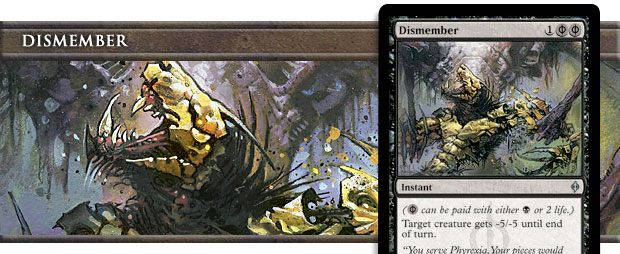

This card was originally -4/-4 for (P/ )(P/
)(P/ ), but the kill being free turned out to be too good so
), but the kill being free turned out to be too good so  was added to the cost and the effect went up to -5/-5.
was added to the cost and the effect went up to -5/-5.
For those who are curious how Ramp;D wrote Phyrexian mana in our design files, we used an exclamation point before the color. For example, Dismember's mana cost would be 1!B!B.
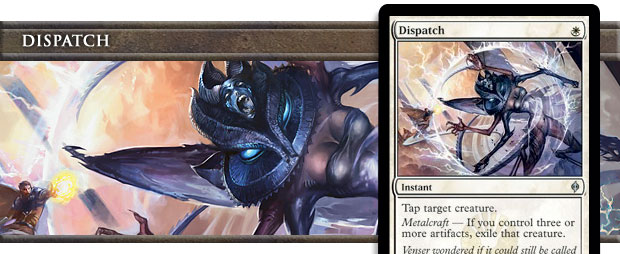

You know what designers love to do? Remake old broken cards such that they hint at the power of the old card without being anywhere close.
Close but no cigar
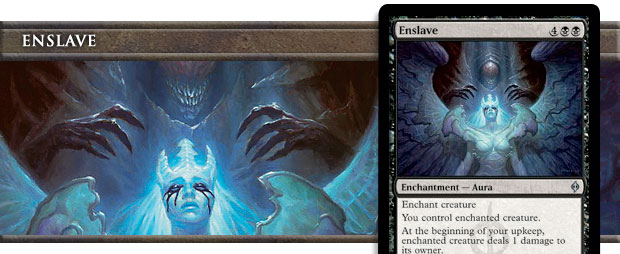

I love doing offbeat reprints that make sense in the set. This card is odd in that it's a repeat from Planar Chaos, a set that was consciously breaking our color pie rules (although in a way we were okay with—really, there's a column about how and when we color bleed coming up soon). So let me set the record straight on who gets to do what with stealing.
As I've explained before, Ramp;D breaks the color pie into three categories when talking about who gets what. There is primary, secondary, and tertiary. Primary gets the effect most. The effect is in most sets and, if appropriate, tends to be seen in common (we limit permanent stealing—that is, the stealing of things permanently as opposed to the stealing of permanents generally—to uncommon and higher for game-play reasons). Secondary gets the effect some of the time and it too can do the effect at common just less often than the primary color. Tertiary means that the color gets to occasionally do it but not often and seldom at common.
Stealing is primary in blue, secondary in red (which mostly gets temporary stealing), and tertiary in black. Enslave is an example of black getting it when it really fits the flavor. Don't expect to see stealing as a regular feature in black. We'll use it when we need it, but it is not something that should happen often.
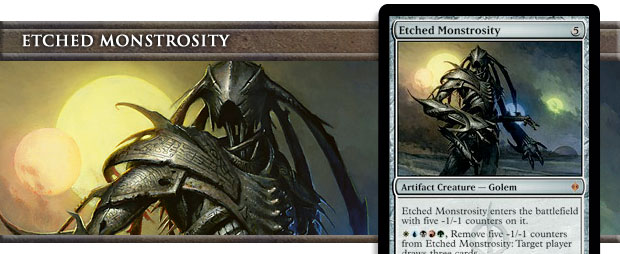

This card is a throwback to the card Etched Oracle from Fifth Dawn. Fifth Dawn was the first set Aaron Forsythe (New Phyrexia's lead developer) worked on, and sunburst was his creation. I don't know for sure that Aaron made this card (there's a good chance he didn't), but I do know he was probably tickled to have it in the set.
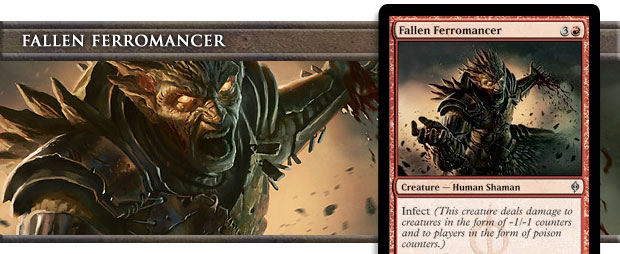

Once infect was locked in as a mechanic in Scars if Mirrodin block, it was a given that the block was going to have a poison Tim. (That's the nickname for the 1/1 that taps to deal 1 point of damage, which began with Prodigal Sorcerer in Alpha. It's a reference to a wizard character in Monty Python and the Holy Grail, an awesome movie you should watch if you can't already quote all the dialogue.) The only question was which set the infect Tim would go into. New Phyrexia won only because red didn't get infect until the final set.


This card was originally in Scars of Mirrodin. What happened? Well, development likes to be able to ramp up a new mechanic so that there is room for good cards with it in every set. If all the good cards with a mechanic are in the first set, then the next two sets can't have any Constructed cards with that mechanic. Because of this, development likes to hold some good cards back. Glistener Elf was one such card for the infect mechanic.


As a designer, I love cards that are self-contained but also open-ended. The -1/-1 counter combining with proliferate is perfect because in a vacuum this card is just "target creature gets two -1/-1 counters," which is plenty fine to play by itself. But the card has the ability to do so many other cool things. This is one of my favorite designs in the set.
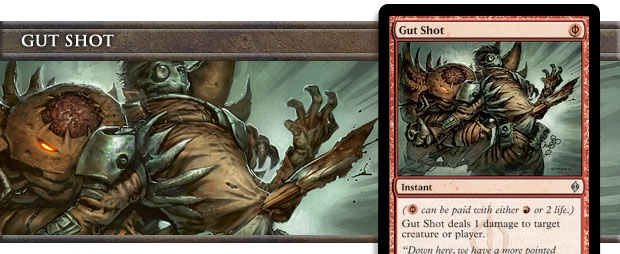

The original version of this card was a Shock (it dealt 2 damage). Playtesting in development quickly showed that to be a bad, bad idea, and it was dropped from 2 damage to 1.
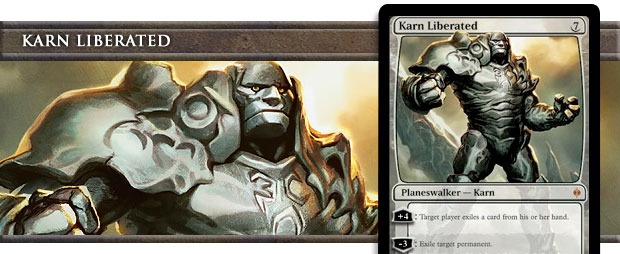

Let me answer the most common questions I've been getting about Karn:
Why isn't he an artifact?
The same reason that Nicol Bolas, Planeswalker isn't a Dragon and Ajani Goldmane isn't a Cat. Planeswalkers transcend any other type or subtype qualities they might have. This is also because there would be trouble fitting the text on the card type line and because having artifact-ness on a planeswalker would cause all sorts of broken combos.
Why does he remove poison when I said no card in the block would remove poison?
My answer is that he doesn't remove poison; he starts the game over. There's a big difference. Saying that's the same thing is like saying red can destroy enchantments because they go away when the red mage deals lethal damage to their controller. If you really want to think of Karn as poison removal then be aware you could have removed poison back in Scars of Mirrodin, because concession was an allowable game action.
I don't mean to come off sounding snarky. I just want to stress that when I say we won't do something, I'm talking very literally. Of course, there will be ways to deal with poison in the block. I just felt for many reasons that it was important that poison be more permanent. Getting poisoned was supposed to be something scary. I do acknowledge that Karn is a sideways answer to poison, but one that comes with a lot of other baggage.
Why couldn't planeswalker Karn have been on the Phyrexian side?
Because then he wouldn't be a planeswalker. The fatal flaw of the Phyrexians is that they can't hold the Planeswalker spark, meaning they are not able to travel between planes. If Karn had ended up on the Phyrexian side, he would have been a legendary creature and not a planeswalker.
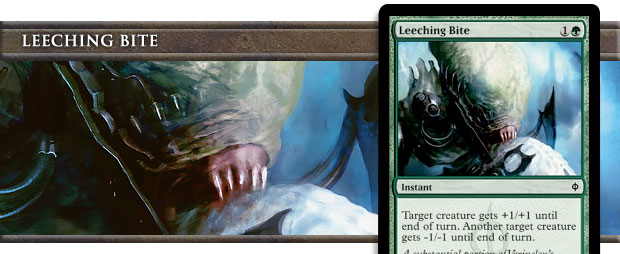

Yes, this is my least favorite card in the set. We had a lot of fights over this card. As my stance on Hornet Sting shows, I'm firmly against green having creature kill. Yes, it has its two big exceptions: fliers and artifact creatures, but I really want the line drawn firmly after that. Note that I'm fine with green using its creatures to fight with the opponent's creatures. In fact, that is how green is supposed to deal with creatures, by using its own creatures. I tried hard (as I did with Hornet Sting) to get this card moved to white, but I was unsuccessful.
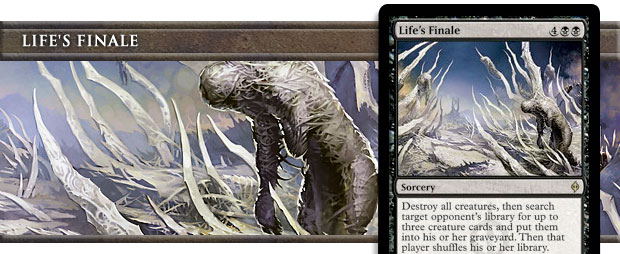

This card, a Ken Nagle design, is my favorite "the Phyrexians not only beat you but kick you while you're down" card. There was worry early on that we wouldn't be able to capture the essence of the Phyrexians in individual card design. As the set shows, there was no reason to worry.
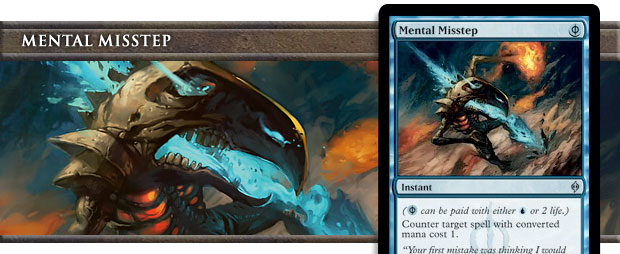

This is the Phyrexian mana card I fought the most against. I liked the idea of free Phyrexian mana cards—it's one of the reasons I convinced Aaron to move the Phyrexian mana to the colored mana (see my column on Phyrexian mana for more)—but I wanted those effects to be things that felt like the kind of bleeds we allow in artifacts. "Counterspelling is one of the most unfun things in the game," I said to Aaron. "Why allow four other colors to do it?"
Be aware that things were much more dire at the beginning of development, as this card began as a Force Spike ("counter unless controller pays  "). Luckily, many developers and I convinced Aaron that it needed to change. I still don't like free countermagic that can be played by anyone, but at least it's very constrained in what it can do.
"). Luckily, many developers and I convinced Aaron that it needed to change. I still don't like free countermagic that can be played by anyone, but at least it's very constrained in what it can do.
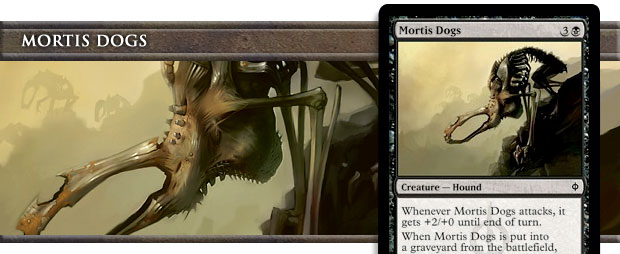

This card is a throwback to this card from Urza's Saga:
I don't know how many of you knew that Hollow Dogs was a Phyrexian creature, but it was, so here we are showing that some things about the Phyrexians go all the way down to their DNA. (Remember that the new Phyrexians have no actual knowledge of the old Phyrexians.)
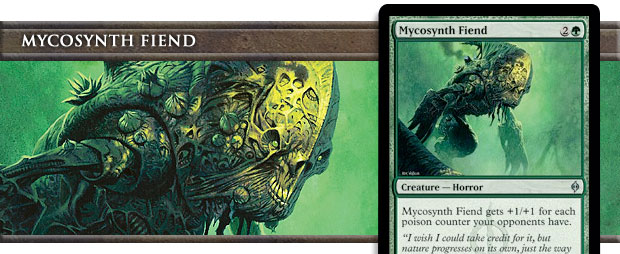

Once we settled on the design for infect in Scars of Mirrodin design, the next big step was understanding the impact the mechanic would have. In Constructed it seemed more than likely that players would go all-in or not use it (with the exception of poison as a tool in a control deck where you only needed a few poison sources). Limited seemed like there was more potential for more variance to happen.
In Limited, for example, players often wouldn't have enough infect cards to only play infect creatures, so they would be forced to mix and match poison with traditional life loss. In Draft, we found that there was enough poison for a few players to go all-in. I was very interested in finding ways to make people want to play infect cards in non-infect decks or play non-infect cards in infect decks.
Solving the first issue was making cards that either used infect in a way other than killing through poison (most often caring about the distribution of -1/-1 counters) or on creatures big enough that the one creature alone threatened a poison kill.
The second issue, though, was a bit dicier. What could we do to make infect decks play creatures that didn't have infect? My team came up with a number of solutions. The Scars development team, though, felt that we should hold back a bit on the poison technology. They wanted to start simple and slowly ramp up how to make poison matter. So Scars of Mirrodin played it pretty straight. For the most part, infect creatures flocked together, leaving non-infect creatures out.
Mirrodin Besieged started dipping its toe in the waters of how to make poison matter in different ways. New Phyrexia ended up being the place where most of this material got printed. As you will see, in Limited there are a lot more nuances to what having some poison means. No longer is poison an on/off consideration. Having one poison means something (you're poisoned). Certain other cards make you care how much poison you have. With the Phyrexians in charge, poison is not as simple as it once was.
Five paragraphs in and I haven't even talked about the card in question. I designed Mycosynth Fiend in Scars of Mirrodin design. It looked odd at first glance, but the card played well. Scars development pulled it from the set when they were simplifying how poison worked. So I did what designers do: I put it into the next set. It was played there and well liked by the design team. Come Mirrodin Besieged development, it was pulled again.
Having played this game a long time, I was unabashed. In the card went into New Phyrexia design, and out it went in New Phyrexia development. One of the perks of being Head Designer is that during each development cycle the lead comes to me and asks my opinion about the set. Is there anything that's in that should be changed or pulled, and is there anything that was pulled that should be put back in? When Aaron asked me this about New Phyrexia, I had an answer: Please put Mycosynth Fiend back in.
Aaron said that his team didn't really like the card. I asked if they played with it, because all three design teams of the block had liked it. Aaron said he'd stick it in a common slot and let playtesting dictate its fate. Aaron came back after the playtest and said that enough of the team liked it that he was going to keep it. The one change they wanted was to move it to uncommon because it was too much of a beatstick at common. Deal, I said. And that is how my favorite card got into the set.
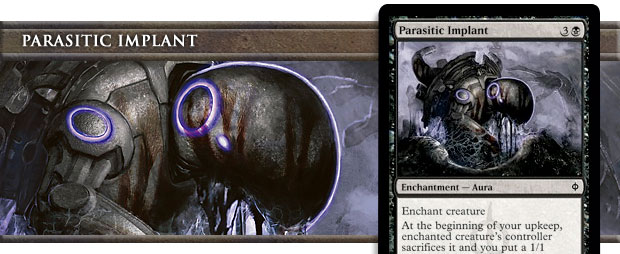

This card's design was based on a famous science fiction movie. Can you name it?
Click here to see if you're correct.

Yes, this card's design was inspired by Alien's most famous scene. I won't spoil it for those who have somehow not seen it (and if you haven't, really go rent it, right after you rent Monty Python and the Holy Grail), but if you've seen the movie, you know the scene I'm talking about.
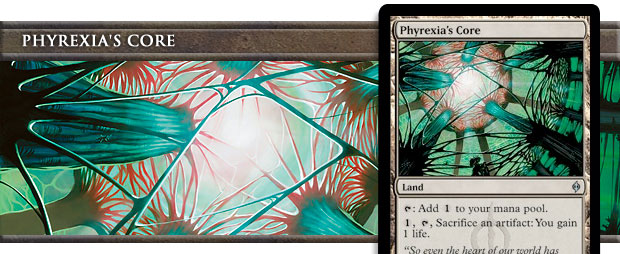

This card came about in an unusual way. The Creative Team really wanted to show how the Phyrexians had corrupted Mirrodin's core. Could we possibly design a card that would allow them to show this? Well, we said, Mirrodin block did have a card called Mirrodin's Core. Perhaps we could tweak it.


Tom talked about Ken's original variant in his column two weeks ago. In case you didn't read Tom's article (and really there's no excuse for that), the original version of this card shuffled your opponent's card into your library. Ken called it the "pwnage" mechanic and put it on several cards. The mechanic was very divisive. In the end a combination of rules and tournament issues struck down the pwnage mechanic. We did spend some time trying to make a lighter version of pwnage, but that tale's for another day.


One of the fun ways to do a throwback is to take a card that has since shifted colors in the color pie and just make the old card but in its new color. That's what this card is doing. Recognize it?
Click here.
Yes, it's a red version of Priest of Gix from Urza's Saga. And yes, Priest of Gix was a Phyrexian. (Gix was a big player among the old Phyrexians.)
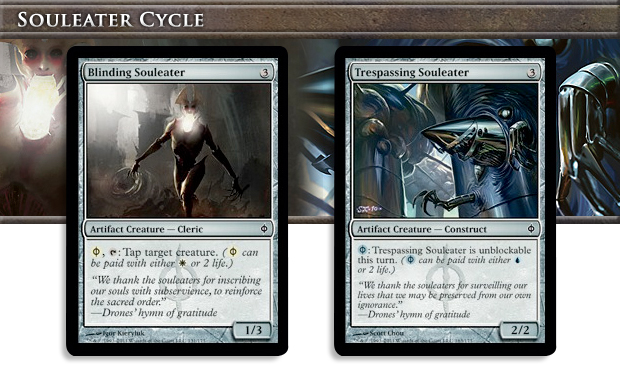
Once we decided to put Phyrexia mana in New Phyrexia, I argued for putting this cycle in the set. I felt like Phyrexian mana as an activation on an artifact created a very different play experience from the colored card using Phyrexian mana in its cost. Anyone could activate these creatures, but only a deck running the color could do it consistently. Having played with them quite a bit, I'm happy I fought for their inclusion.
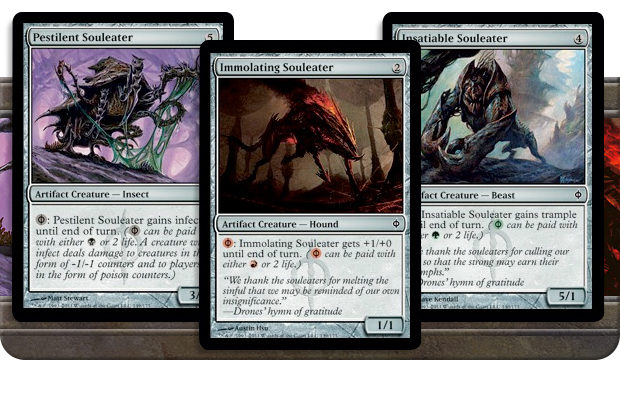


I've gotten a few letters wondering why this card didn't cost Phyrexian mana to activate. The reason is simple: we chose to only put Phyrexian mana activations on one cycle of artifact creatures (the Souleater cycle above) and cards that had Phyrexian mana in their mana cost. While Toxic Nim's activation would have been cool as Phyrexian mana, we felt it was important to be consistent with how we applied Phyrexian mana activations. (Design does love its structure.)
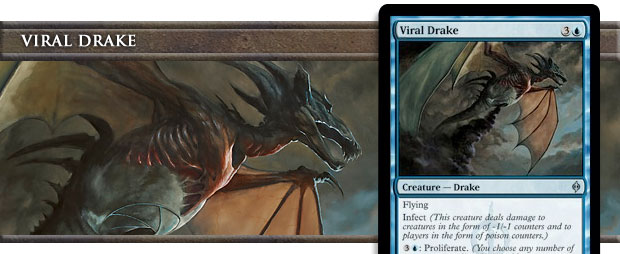

I was sad that Mirrodin Besieged didn't have a blue card with repeatable proliferate, so I pushed hard to make sure that New Phyrexia had one. Infect flier with activated proliferate—mission accomplished!
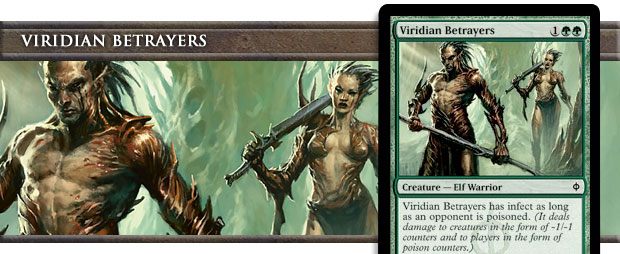

This card's design came out of the designers trying to find a way to make a card that played in an infect deck and a non-infect deck. It's funny how often cool cards come out of forcing restrictions on yourself. (All right, everyone together: "Restrictions breed creativity.")


During Mercadian Masques design I made this card:
Conspiracy was created in black at the time because we were trying to help out Mercenary decks. (Mercenaries were like Rebels except instead of going up in mana costs they went down—apparently a pretty big deal.) I'm not sure why I talked myself into black being okay for this effect, but for many years this was the card you had to use to unify all your creatures. Xenograft brings the ability (although in a truncated form, affecting only creatures on the battlefield) to the color that should really have had it all along. (And yes, blue was able to do this temporarily in spells.)
- In the Cards
That's all the time I have for today. I hope you enjoyed my traditional trip down memory lane.
Join me next week when I talk about the mana my dreams.
Until then, may you have many people wanting to hear your stories at work.

